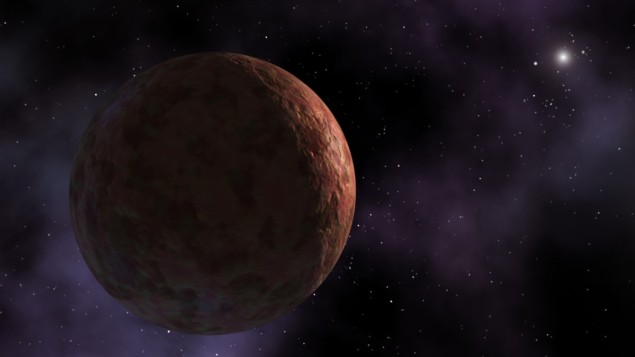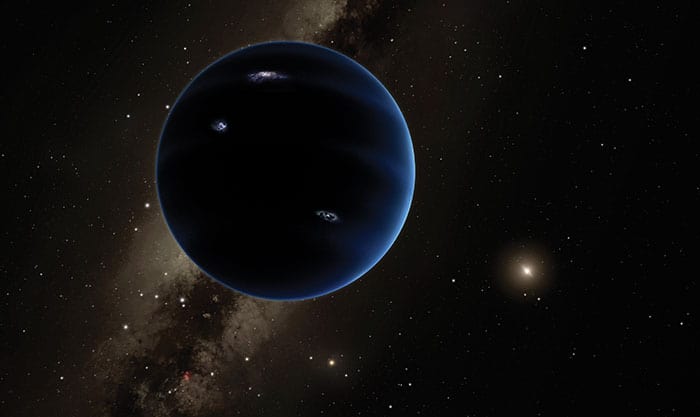Earth-sized planet could be lurking at the edge of the solar system, simulations suggest

Strange motion: the minor planet Sedna – shown in this artist’s impression – was one of the TNOs studied by Lykawka and Ito. (Courtesy: NASA/JPL-Caltech/R. Hurt (SSC-Caltech))
A hidden planet with a mass about 1.5–3 times that of Earth could be lurking at the edge of the solar system, according to computer simulations done by researchers in Japan. Kindai University’s Patryk Sofia Lykawka and Takashi Ito at the National Astronomical Observatory of Japan have found that the unexplained properties of some solar system bodies could be evidence for the planet, which would orbit about 200 au from the Sun (200 times the distance between the Earth and the Sun).
The duo uncovered evidence for the hidden planet by focusing on several unexplained phenomena associated with trans-Neptunian objects (TNOs). These are minor planets that orbit in the Kuiper Belt beyond Neptune. These phenomena included the unexplained presence of “detached objects” that have orbits beyond the influence of Neptune’s gravity; and the “high-i” TNOs, which have orbits that are highly inclined in comparison with the majority of Kuiper Belt objects.
Using powerful computer simulations of solar-system dynamics, they concluded that these phenomena cannot be explained by our current view of an outer solar system containing the four giant planets Jupiter, Saturn, Uranus and Neptune. Rather, the simulations suggest that the presence of an Earth-sized planet beyond Neptune can explain these TNO phenomena.
Not Planet Nine
The idea that a hidden planet exists at the edge of the solar system is not new, with the most famous recent example being “Planet Nine”. This was proposed in the 2010s as a planet with a mass about six times that of Earth and an orbit at about 500 au.
While their proposed planet is smaller and closer to the Sun than Planet Nine, Lykawka and Ito did also consider other possible configurations for their hypothetical planet. The duo modelled three possible distances: a large orbit between 200–800 au; a medium orbit of 200–500 au; and a small orbit at 200–300 au. They found only the medium and small orbits were good fits for the TNO properties they considered.
The team also looked at other masses for their hypothetical planet, but found that smaller planets did not produce populations of detached or high-i TNOs large enough to match observations.
While the proposed planet is Earth-like in terms of its mass, its distance from the Sun would make it a very different place, as Lykawka explains. “The planet’s favoured orbits would imply very cold surface temperatures, perhaps never above −240 °C”.
Icy volcanoes
However, such a large object would probably have an internal energy source, implying the existence of subsurface oceans and perhaps higher surface temperatures. It could also have volcanoes that erupt ice instead of lava and other interactions between its interior and surface.
“The planet could also have mountains, ridges, polar caps, glaciers, plains, etc.,” Lykawka adds. “I speculate, therefore, geologically speaking, the planet could also be considered Earth-like — an active icy and rocky Earth.”
Theories of hidden planets are controversial, so Lykawka is ready for some pushback. “Our research is not the first to propose the existence of an undiscovered planet in the outer solar system, and all the surveys performed so far have not discovered a planet beyond Neptune,” he explains. “I expect the scientific community to be sceptical, but perhaps less so than in the recent past.”
This because Lykawka believes their study is the first to tackle and reasonably explain various observational constraints in the distant Kuiper Belt in a single scenario. The research has already caught the interest of the planetary scientist Samantha Lawler, who describes herself as a “Planet Nine sceptic”. Based at Canada’s University of Regina, Lawler works on the Outer Solar System Origins Survey (OSSOS), which has helped diminish evidence supporting prior Kuiper Belt planet theories.
“I expected to be sceptical, but I was actually very impressed,” Lawler told Physics World. “The research doesn’t perfectly explain everything, but it makes some of these weird things that we see with Kuiper Belt objects easier to explain. An Earth-sized Kuiper belt planet is not ‘definitely the right answer’ but this work is on the way to explaining a lot of things that we can’t currently explain.”
Given its distance from Earth, and that the duo have not predicted the precise location of their planet, it would be very difficult to observe. Lawler, however, points to the success of OSSOS, which discovered over 800 new Kuiper Belt objects with the MegaPrime camera on the 3.6 m Canada-France-Hawaii Telescope (CFHT).
“We can keep finding new Kuiper Belt Objects, and this is within the reach of current ground-based surveys,” she says. “It could be discovered if it’s actually out there.”
The research is described in The Astronomical Journal.
FROM PHYSICSWORLD.COM 16/9 /2023

Δεν υπάρχουν σχόλια:
Δημοσίευση σχολίου